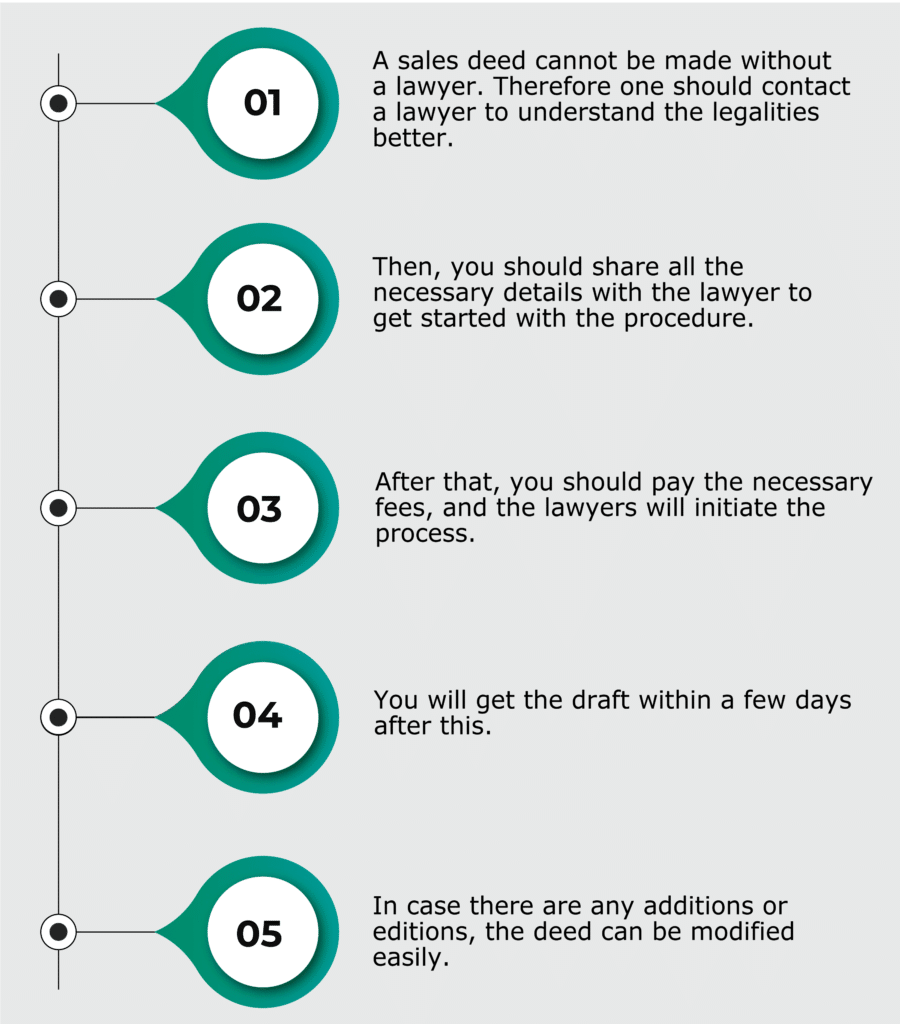What is a Sale Deed?

A Sale deed is widely used among real estate agents and property dealers. This legal document is significant proof of the ownership of any property.
The acquisition or sale of a property is not completed legally unless the buyer and seller sign a sale deed. Normally, a sale deed is signed only after both parties are satisfied and comply with the terms and conditions.
In simple language, a sale deed is also referred to as a “sale bill.” The term “bill” refers to a legal assignment that can be used by both buyer and seller. The word “sale” in this context points to the fact that it can be used for the benefit of any kind of property, including land, building, farmhouse, or any movable or immovable properties.
A sale deed includes some other details like the name of the buyer, the name of the seller, rate of stamp duty, the amount paid by the buyer as registration fee, the date on which a contract was made between the two parties. This document also includes information about how much money has been received by whom from whom. It contains the names and addresses of all parties involved in buying or selling property. This information can be easily verified from their signatures on this legal paper.
Parties Involved In Sale Deed
A sales deed is the most common form of real estate transaction in the country. Sales deeds are used to transfer the title of a property from one party to another. A sales deed must be signed by both parties involved in the transaction, and it is made valid when it is registered with the Registrar.
It should contain details like the date, name, age, and address of all the parties involved in the transaction. It should also have the nature of the property being sold, the amount paid for its purchase, the price offered, and other details that help in the identification of property like landmarks, etc.
What does a sale deed imply?
A sale deed is a primary document that serves as proof of ownership of immovable property. The deed is created on non-judicial stamp paper. It can be used to sell any kind of property, including land and residential or commercial property.
The sale deed is a legally binding document that has to be registered with the relevant authorities. It must be signed by both parties in the presence of witnesses. The seller should ensure that he/she has cleared all the dues and charges related to the property before signing it.
After the seller and buyer sign the deed and get it registered, the title of the property will be transferred from seller to buyer.
Importance of Sale Deed
In case you are wondering why you should use a sale deed, here are some of the advantages that this legal document can offer-
The importance of sale deed are:
- It provides official proof of ownership
- It prevents ownership disputes
- It gives security to the purchaser.
It helps in getting loans, mortgages, etc.
What should be included in a sale deed?
The sale deed should have these below-mentioned content-
- Information about the parties involved- a sale deed should disclose all the particulars about the parties involved. Their full name, address, occupation involved, age, and contact details.
- Information about the property transferred- a sale deed should disclose all the information about the property being transferred. Its complete address, any construction or repairs going on, dimensions, and any other details.
- The clause related to indemnity- a sale deed should include a clause related to the indemnity from the seller that property is free from any mortgage, charge, litigation, hindrance if any. And the buyer should indemnify the seller for any remaining payments.
- The seller should clear any loans pending against the property he is going to sell. And the buyer has all the rights to check the documents and verify everything.
- Particulars regarding the sale consideration should be mentioned in the sale deed as well. Any amount paid in advance, date in which payment is to be made, mode of payment, and other details, if so, should be particularly mentioned and agreed upon by both parties.
- The sale deed should also contain the receipts of transactions occurring between the parties.
- The sale deed should also contain all the details about the payment and delivery of the possession.
Procedure Of Getting a Sale Deed

- A sales deed cannot be made without a lawyer. Therefore one should contact a lawyer to understand the legalities better.
- Then, you should share all the necessary details with the lawyer to get started with the procedure.
- After that, you should pay the necessary fees, and the lawyers will initiate the process.
- You will get the draft within a few days after this.
- In case there are any additions or editions, the deed can be modified easily.
Registration of a Sale Deed
When you are registering a sales deed, you have to follow these steps to make the registration process efficient and seem easier.
Both the parties have to submit necessary documents to the sub-registrar to initiate the process. These documents should be there to initiate the process-
- The rates of the property will be determined as per the region, and the same should be disclosed in the deed.
- As per the rules, the price of the region and the one decision should be related to each other. And if the actual price paid is different from the stamp duty value, then the higher of these two should be taken into consideration.
- Subsequently, a non-judicial stamp has to be bought and pasted.
- After all of this, the deed has to be prepared in a type and printed in a stamp format.
- The last step is to submit everything with the sub-registrar office and get the sale registered. And there must be two witnesses by both of the parties to complete the process.
Cancellation Of A Sale Deed
A deed is a legal document that is an agreement between the seller and the purchaser. A deed of cancellation is a legal document that cancels the agreement or contract of sale. The clause for cancellation of a deed can be written in the deed itself or any other document attached to the deed.
The cancellation process can be initiated even when one party requests for cancellation but the cancellation process can be executed only when both parties sign the document.
The cancellation of the deed can be done by both parties as well if there is a related agreement to this. It can be written that if either party demands cancellation, then there will be a cancellation of the sale agreement. This can be done by writing it in the agreement itself or any other document attached to it.
Certain conditions should be met to finish the cancellation process
Some conditions are as follows:
- Both parties must agree on the fact that they want to cancel their sale agreement.
- The said party must have some reason for requesting for cancellation of a deed, such as a default in payment or some fault committed by the other party. Or it can be due to forgery, fraud, or force.
- The party who wishes for cancellation must have legal right over his property being sold, or otherwise, he cannot get done with the cancellation process.
Difference Between Sale Agreement And Sale Deed
A sale agreement is a contract between a buyer and a seller wherein the property of one party is exchanged for money or other valuable consideration. The agreement states that the buyer becomes the owner of the property as soon as the agreed amount is paid.
A sale agreement is different from a sale deed. The sale deed includes all documents (such as bill of sale, deed of conveyance, etc.) executed by both parties during the process of transfer of ownership.
The main difference between a sale agreement and a sale deed is that a sale agreement is just an agreement stating that a sale shall happen on the terms as agreed upon by the parties concerned, whereas a sale deed includes all documents executed by both parties during the process of transfer of ownership.
A sale agreement operates on a “when” rather than “if” basis. Both parties are aware that irrespective of any future contingencies, they will have to fulfill their respective obligations and then be legally bound to transfer ownership in favor of each other.
Should you purchase a property without a sale deed?
A buyer of a property must be very careful in the purchase of any property. A buyer must make sure that the seller is the legal owner of the property by checking with the revenue department and then checking for the title deed.
Many times it has been seen that original title deeds are missing because someone may have taken a loan against this property, and the original deeds might have been seized by the bank as security against the loan amount, or they might have been used as collateral security against a loan.
The original deed may have been seized as evidence in pending litigation. So it is a must to get all these documents checked before proceeding to buy a property. Legal documents like sale agreement, mortgage deed, lease deeds, affidavits from all concerned parties should be taken for verification of the authenticity of the said property.
When we talk about real estate purchases, then we are talking about something which will stay with you for many years, so it is very important to look into every minute detail before buying any kind of property.
One should be very careful while buying an under-construction project or resale project as many things need to be verified before finalizing any kind of deal. It is said that sometimes problems start even during the construction stage itself and sometimes after completion also.
Conclusion
A sale deed is a legal document that is signed by the buyer and the seller before transferring ownership of any property. This document contains details like the name and address of the buyer, seller, rate of duty, registration fee, the date on which a contract was made between both parties, etc. These details can easily be verified from their signatures on this legal paper.
Before buying any property, one must go through its sale deed because it has all the details about that particular property. If there is any discrepancy found in its contents, then it may create problems for you in the future. So, therefore, before buying any property, make sure that you have complete knowledge about its sale deed because it will help you to avoid unnecessary issues.
FAQ’s
Two parties involved in the sales deed are the buyer who is willing to purchase the property and the seller who is willing to sell his property.
No, you need a lawyer to register a sale deed. Without a lawyer, you cannot initiate the process.
The basic requirements are the details of the parties, details of the property, rate of the property, and advance if taken any.
No, you do not need nominees, but you need witnesses(both the parties) to get a sales deed registered.
